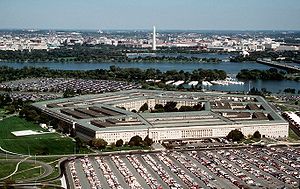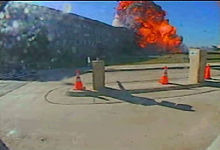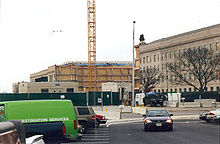The Pentagon: Difference between revisions
Undid revision 186076400 by High on a tree (talk) |
|||
| Line 163: | Line 163: | ||
{{portalpar|Military of the United States|Naval Jack of the United States.svg|65}} |
{{portalpar|Military of the United States|Naval Jack of the United States.svg|65}} |
||
{{commons|Pentagon (building)}} |
{{commons|Pentagon (building)}} |
||
*[http://rapidshare.de/files/38339307/Pentagon_28_10_2007.zip.html Mirror of Pentagon Website (state of Octomber 28, 2007)] |
|||
*[http://www.pfpa.mil Pentagon Force Protection Agency] |
*[http://www.pfpa.mil Pentagon Force Protection Agency] |
||
* [http://pentagon.afis.osd.mil The Pentagon website] |
* [http://pentagon.afis.osd.mil The Pentagon website] |
||
Revision as of 02:17, 24 January 2008
| The Pentagon | |
|---|---|
| Arlington, Virginia | |
 Southwest view of the Pentagon with the Potomac River and Washington Monument in background | |
| Type | Headquarters building |
| Site history | |
| Built | 1943 |
| In use | 1943 – present |
| Battles/wars | 2001 terrorist attacks |
| Garrison information | |
| Garrison | Joint Chiefs of Staff Department of Defense |

- This article is about the United States military building. For the shape, see Pentagon.
The Pentagon is the headquarters of the United States Department of Defense, located in Arlington, Virginia. As a symbol of the U.S. military, "the Pentagon" is often used metonymically to refer to the Department of Defense rather than the building itself.
Designed by architect George Bergstrom (1876 - 1955) and built by Philadelphia, Pennsylvania general contractor John McShain, the building was dedicated on January 15, 1943 after ground was broken for construction on September 11, 1941. Colonel Leslie Groves was responsible for overseeing the project in 1940-42, and his administrative ability, drive and forcefulness led to his nomination to head the Manhattan Project in 1942.
The Pentagon is one of the world's largest office buildings.[1] It houses approximately 23,000 military and civilian employees[1]and about 3,000 non-defense support personnel. It has five sides, five floors above ground (plus two basement levels), and five ring corridors per floor with a total of 17.5 miles[1] (28.2 kilometers) of corridors.
The Pentagon Force Protection Agency is a United States government agency comprising both sworn Federal Police Officers, the United States Pentagon Police and civilian CBRN technicians, as well as non-sworn civilian anti-terrorism investigative and physical security personnel, and is responsible for the protection of the Pentagon, headquarters of the United States Department of Defense (DoD). In response to the terrorist attack against the Pentagon on September 11, 2001, the DoD established the new agency, which absorbed the Defense Protective Service (DPS), and assumed its role of providing basic law enforcement and security for the Pentagon and DoD interests in the National Capitol Region (NCR).
PFPA expanded that mission to provide force protection against the full spectrum of potential threats through robust prevention, preparedness, detection, and response measures. The agency provides those services to the 280 acre (1.1 km²) "Pentagon Reservation" as well as numerous other Department of Defense activities and facilities within the NCR. The United States Pentagon Police is the primary federal law enforcement arm of the Pentagon Force Protection Agency.
At five acres (20,000 m²), the central plaza in the Pentagon is the world's largest "no-salute, no-cover" area[2] (an area exempt from the normal rule that, when out of doors, U.S. military personnel must wear hats and salute superior officers) outside of a combat zone. The open space in the center is informally known as "ground zero," a nickname originating during the Cold War and based on the presumption that the Soviet Union would target one or more nuclear missiles at this central location. At the center of this plaza is the "Ground Zero Cafe," a snack bar.[3]
Just south of the Pentagon are Pentagon City and Crystal City, extensive shopping and high-density residential districts in Arlington. Arlington National Cemetery is to the north. The Washington Metro Pentagon station is also located at the Pentagon, on the Blue and Yellow Lines. The Pentagon is surrounded by the complex Pentagon road network.[4]
Construction

Prior to the construction of the Pentagon, the War Department was housed in a series of "temporary" buildings erected during World War I which nearly covered the National Mall. Ground was broken for the Pentagon on September 11, 1941, with construction completed in approximately sixteen months at a cost of $83 million. A minimal amount of steel was used in construction, which was in short supply during World War II. 680,000 tons of sand, dredged from the Potomac River, were used in the reinforced concrete structure.[5]

Its unusual shape results from the fact that its originally intended site, Arlington Farms, fronted on Arlington Ridge Road and the Arlington Memorial Bridge approach, which intersected at an angle of approximately 108 degrees (the angle of a regular pentagon).[6] President Franklin D. Roosevelt had it constructed at its current location because he didn't want the new building to obstruct the view of Washington, D.C. from Arlington Cemetery,[7] but the building retained its pentagonal shape because a major redesign at that stage would have been costly and because Roosevelt liked the design. Freed of the constraints of the asymmetric Arlington Farms site, however, it was modified into a regular pentagon.[8]
History
Peace protests

During the late 1960s the Pentagon became a focus for peace protests against the Vietnam War. In one of the better known incidents, on October 21, 1967, some 35,000 anti-war protesters organized by the National Mobilization Committee to End the War in Vietnam, gathered for a demonstration at the Defense Department (the "March on the Pentagon"), where they were confronted by some 2,500 armed soldiers. Abbie Hoffman satirically declared the group's intention of levitating the Pentagon 300 feet (90 m) by means of meditation, wobbling it once in mid-air in order to exorcise evil spirits. Several protesters allegedly maintain to this day that they were briefly successful in this endeavor.[citation needed]
On May 19 1972, the American radicals known as the Weather Underground Organization successfully planted and exploded a bomb in a Pentagon restroom in retaliation for the Nixon administration's bombing attacks on Hanoi during the final stages of the Vietnam War.
On March 17 2007, an estimated 10,000 to 15,000 protested the Iraq War.[9] The protesters marched from the Lincoln Memorial, down Route 27 to the Pentagon North Parking Lot.
Renovation
As originally built, most Pentagon office space consisted of open bays which spanned an entire ring. These offices used cross-ventilation from operable windows instead of air conditioning for cooling. Gradually, bays were subdivided into private offices with many using window air conditioning units.
Since 1998, the Pentagon has been undergoing a major renovation, known as the Pentagon Renovation Program. This program, scheduled to be completed in 2010, involves the complete gutting and reconstruction of the entire building in phases to bring the building up to modern standards, removing asbestos, improving security and providing greater efficiency for Pentagon tenants. Recently, the process of sealing all of the building's windows began.
The new space will include a return to open office bays, with a new Universal Space Plan of standardized office furniture and partitions developed by Studios Architecture.[10]
In the center courtyard a refreshment stand called the "Ground Zero Cafe", is being replaced with a more modern restaurant.
September 11, 2001




Exactly 60 years to the day after the groundbreaking ceremony, the September 11, 2001 attacks occurred. American Airlines Flight 77 crashed into the west side of the Pentagon after being hijacked, killing all aboard as well as over a hundred people within the Pentagon. The flight penetrated three of the five rings of the Pentagon. Because the affected area was under renovation at the time, several offices were unoccupied, sparing many lives. The aircraft struck on the edge between two sections—one of which had just finished being upgraded.
Contractors involved in the Pentagon Renovation Program were also charged with the task of rebuilding the damaged section of the Pentagon following the attacks. This additional project was named the "Phoenix Project", with the goal of having the outermost offices in the damaged section occupied again by September 11, 2002. Part of the pre-attack renovation had involved adding improved security features, including walls and windows with greater blast resistance. An initial analysis suggested that the section's improvements had saved lives, enabling more people to evacuate. Repairs included demolition of the damaged areas, complete rebuilding of the area that had previously been renovated, and reconstruction of the shell of the unrenovated section. The first Pentagon tenants whose offices were damaged in the attack began moving back in on August 15, 2002, nearly a month ahead of schedule.[12][13] The repairs cost the Department of Defense about $500,000,000. Before the September 11, 2001 attacks, an escalator ran from the Metro station to the Pentagon lobby. After the attack this escalator was blocked off and later removed as part of the Pentagon Renovation Program.
Pentagon Memorial
A memorial is being constructed at The Pentagon in memory of those who died at The Pentagon and on American Airlines Flight 77.[14][15] Construction of the memorial is scheduled for completion by September 2008.[16]
For the 5th anniversary of the September 11, 2001 attacks, a memorial of 184 beams of light shone up from the center courtyard of the Pentagon, one light for every victim of the attack.
Food Services
The Pentagon has many of its own fast food operations, including Subway, McDonald's, Dunkin' Donuts, Panda Express, KFC, and Taco Bell restaurants, operated by the Navy Exchange.
This section needs expansion. You can help by adding to it. |
Navigating the building
There is a concourse on the southeast side of the second floor of the building. It contains a mini-shopping mall. Located near the Metro bus and rail stations, this is the main entrance for visitors.
Floors in The Pentagon are lettered "B" for Basement and "M" for Mezzanine, both of which are below ground level. The concourse is located on the second floor at the metro entrance. Above ground floors are numbered 1 to 5.
The concentric rings are designated from the center out as "A" through "E" (with addition "F" and "G" in the basement). "E" Ring offices are the only ones with outside views and are generally occupied by senior officials.
Office numbers go clockwise around each of the rings, and have two parts: a nearest-corridor number (1 to 10) followed by a bay number (00 to 99), so office numbers range from 100 to 1099. These corridors radiate out from the central courtyard, with corridor 1 beginning with the Concourse's south end. Each numbered radial corridor intersects with the corresponding numbered group of offices (for example, corridor 5 divides the 500 series office block).
Room numbers are given as the floor, concentric ring, and office number (which is in turn the nearest corridor number followed by the bay number). Thus, office 2B315 is on the second floor, B ring, and nearest to corridor 3 (between corridors 2 and 3). One way to get to this office would be to go to the second floor, get to the A (innermost) ring, go to and take corridor 3, and then turn left on ring B to get to bay 15. [17]
Tours
There are a number of historical displays in the building, particularly in the "A" and "E" rings. In 1976, the Pentagon began offering guided tours to the general public, as part of the American Bicentennial.[18] Tours for the general public were suspended after the September 11, 2001 attacks, and are now only available on a pre-arranged basis to veterans and other groups.
Recreation
The Pentagon Athletic Center (PAC), a fitness center for military and civilian staff, opened in 2004[19] adjacent to the north side of the Pentagon, replacing the Pentagon Officers Athletic Club (POAC) which had operated for 55 years in a structure between Route 110 and the parade grounds.
Each year, the Pentagon grounds are a major focus for hosting the Marine Corps Marathon and the Army Ten-Miler running events.
Pentagon in popular culture
Abbie Hoffman's comment about levitating the building during the October 21, 1967 demonstration became the basis for the plot element in the metafictional novel Illuminatus! by Robert Shea and Robert Anton Wilson that the soldiers prevented the levitation because it also would have exorcised the Lovecraftian Outer God Yog-Sothoth, deliberately entrapped within the Pentagon by the Illuminati.[1]
Facts and figures
- Construction began September 11, 1941, exactly 60 years before the September 11, 2001 attacks.
- Construction was completed on January 15, 1943.
- Total cost of project (including outside facilities) was $83,000,000 (over $940 million in 2005 dollars).

Land
- Total land area: 583 acres (236 ha)
- Location: 38.87099°N, 77.05596°W
- Cost: $2,245,000
- Area covered by Pentagon bldg: 29 acres (12 ha)
- Area of center court: 5 acres (2 ha)
- Access highways built: 30 miles (48 km)
- Overpasses and bridges built: 35
Parking
- Parking space: 67 acres (27 ha)
- Capacity (vehicles): 8,770
Main building
- Cost of building: $49,600,000
- Gross floor area: 6,636,360 sq ft (616,540 m2)
- Cubic contents: 77,015,000 cu ft ([convert: unknown unit])
- Length of each outer wall: 921 ft (281 m)
- Height of building: 77 ft 3.5 in (24 m)
- Number of floors, plus mezzanine and basement: seven, five above ground, two below
- Total length of corridors: 17.5 miles (28 km)
- Protected by the Pentagon Force Protection Agency- United States Pentagon Police
Numbers
- Stairways: 131
- Escalators: 19 - many more than that now that renovation is ongoing
- Elevators: 13
- Windows: 7,754
- Rest rooms: 284 ("It was constructed with twice the number of bathrooms needed for the number of employees — segregated Virginia required separate facilities for "white" and "colored" persons.")[20]
- Fixtures: 4,900
- Drinking fountains: 691 (See "Rest rooms" above)
- Clocks installed: 4,200
- Light fixtures: 16,250
- Daily lamp replacements: 250
- Total glass area: 7.1 acres (309,276 square ft)
- Telephone cable: 100,000 miles (160,000 km)
- Telephone calls made daily: 200,000
- Pieces of mail handled monthly by the Defense Post Office: 1,200,000
Zip Codes
- Even though the building is located in Virginia, the United States Postal Service requires that "Washington, D.C." be used in conjunction with the six ZIP Codes assigned to it:
- 20301 - Secretary of Defense
- 20310 - Army
- 20318 - Joint Chiefs of Staff
- 20330 - Air Force
- 20350 - Navy
- 20380 - Marine Corps

References
- ^ a b c The Pentagon, Facts & Figures (accessed January 19, 2008)
- ^ "Dodona Manor - Docent's Corner" (PDF). The George C. Marshall International Center. September 2006. pp. p. 4. Retrieved 2007-06-29.
- ^ Hoffman, Lisa (29 September 2006). "The 'Ground Zero Cafe' bites the dust". Capitol Hill Blue. Retrieved 2007-01-14.
{{cite news}}: Check date values in:|date=(help) - ^ "Mixing Bowl Interchange Complex". roadstothefuture.com. Retrieved 2006-11-22.
- ^ McGrath, Amanda (May 26, 2007). "How The Pentagon Got Its Shape (Gallery)". The Washington Post.
- ^ Bureau of Public Roads memorandum, October 25, 1960.
- ^ "General Information". Retrieved December 4.
{{cite web}}: Check date values in:|accessdate=(help); Unknown parameter|accessyear=ignored (|access-date=suggested) (help) - ^ Vogel, Steve (May 27, 2007). "How the Pentagon Got Its Shape". Washington Post. pp. W16. Retrieved 2007-05-26.
- ^ "4 Years After Start of War, Anger Reigns", Washington Post, 2007-03-17 page A1
- ^ Renovation of the Pentagon. Retrieved Oct. 7, 2006.
- ^ "Flight 77, Video 2". Judicial Watch.
- ^ "Pentagon Renovation Program". Retrieved December 4.
{{cite web}}: Check date values in:|accessdate=(help); Unknown parameter|accessyear=ignored (|access-date=suggested) (help) - ^ "Americas: Pentagon staff reclaim destroyed offices". BBC News. Retrieved December 4.
{{cite web}}: Check date values in:|accessdate=(help); Unknown parameter|accessyear=ignored (|access-date=suggested) (help) - ^ Pentagon Memorial Web Site.
- ^ Official Press release at the United States Department of Defense.
- ^ Dwyer, Timothy (February 1, 2007). "For Pentagon Memorial, the Power of Touch". The Washington Post.
- ^ "How to Find a Room in the Pentagon". Headquarters, Dept. of the Army. Retrieved September 13.
{{cite web}}: Check date values in:|accessdate=(help); Unknown parameter|accessyear=ignored (|access-date=suggested) (help) - ^ Stewart, Stephen (1982 April 18). "Penetrating the Pentagon". The New York Times. pp. Section 10, page 39.
{{cite news}}: Check date values in:|date=(help); More than one of|author=and|last=specified (help) - ^ http://renovation.pentagon.mil/pac/pac.htm
- ^ Virginia places.
External links
- Mirror of Pentagon Website (state of Octomber 28, 2007)
- Pentagon Force Protection Agency
- The Pentagon website
- Pentagon Renovation Program
- The Worldwide Network of US Military Bases
- Navigating the Pentagon
- Great Buildings Online - The Pentagon
- How the Pentagon Got Its Shape - The Washington Post, May 26, 2007
Template:Geolinks-US-hoodscale
- Satellite image from Mapygon
